A white bike adorned with flowers sits at the intersection of L Street NW and Connecticut Ave NW. The bike represents the spot where Nijad Huseynov died while riding his bike in October.
A driver hit Huseynov, a 24-year-old grad student at George Washington University, riding his bike crossing Connecticut Ave on Oct. 17. He later died from his injuries.
DC Families for Safe Streets, an organization of volunteers personally impacted by traffic violence and fighting for improved safety, helped organize the bike memorial. Christy Kwan is the volunteer co-chair of the group.
“A ghost bike is also a memorial and a visual reminder that a crash had occurred there at that specific location,” said Kwan.
Huseynov’s death is one of 45 traffic fatalities in the District in 2023. The number of deaths is up 55% from December 2022, when 29 people died. This year also marks the highest number of traffic deaths in D.C. in the past 16 years.
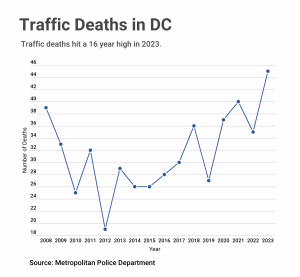
Mayor Muriel Bowser launched Vision Zero in 2015. At that time, the Mayor established 2024 as the goal year for eliminating traffic fatalities and serious injuries. The city has since fallen short.
The initiative “aims to improve pedestrian and bicycle transportation safety by showcasing effective local actions, empowering local leaders to take action, and promoting partnerships to advance safety for all traveling on District streets,” according to Vision Zero’s website.
Advocates like Kwan want to see the city do more to correct this trajectory. Kwan points to a D.C. audit report from March that cited a lack of funding as a major reason why the road safety initiative has yet to be successful.
“I think what has frustrated us as people personally impacted by traffic violence is we will go through the motions to testify at District Council hearings about what we see on the ground and how we have to always speak up for safety, but what we see in terms of parties in the budget is that routinely, things will be not fully funded,” Kwan said.
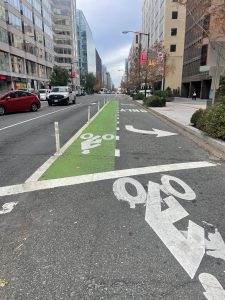
The Washington Area Bicyclist Association also urges DDOT and the Mayor’s Office to make changes such as building more protected bike lanes, enforcing bus-only lanes and improving post-crash care. Advocacy Director Jeremiah Lowery said he wants a safe commuting space for all in the city. Lowery said there isn’t one right now.
“From my perspective, we’re failing,” said Lowery. “I mean, bottom line, you know, we’re failing because the goal is zero.”
The District government is still committed to making Vision Zero successful. The District Department of Transportation is working to redesign roadways, use and expand traffic cameras, and prioritize transit. DDOT and the Metropolitan Police Department meet and follow up on possible safety improvements after every fatal crash in the District.
MPD also performs weekly traffic safety checkpoints at locations prone to crashes.
The Dupont Circle ANC, which neighbors the ANC where the intersection of L Street NW and Connecticut Ave NW is located, approved a resolution in November honoring Nijad Huseynov and calling for DDOT to correct weaknesses at the intersection where Huseynov died as well as others around the District.
Commissioner Jeffrey Rueckgauer sponsored the resolution and chairs the Dupont Circle ANC Mobility Committee. Rueckgauer said it’s infuriating to see traffic deaths increase instead of decrease in the city. He also expressed his concern to DDOT about the dangers of L and M Streets NW during a Mobility Committee meeting Monday night.
“You’ve got to focus on putting people first,” Rueckgauer said. “So it’s a whole series of missed opportunities, frustrations and things that have resulted in a no-improvement situation.”
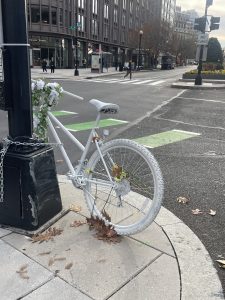
The Dupont Circle resolution also calls for “special attention to those interacting with bike lanes, to improve safety for all, especially the most vulnerable non-vehicular users.”
Rueckgauer said that in addition to increased funding for DDOT’s projects, he wants to implement lower-cost improvements, such as adding flex posts at dangerous intersections to help slow people turning.
“Yes, it costs for the labor, but compared to people losing loved ones, or the city being sued for injuries or wrongful death, it’s a lot cheaper to be proactive with these things and they’re just not,” Rueckgauer said.
The DC Council is currently considering four traffic safety bills. The bills include one that would suspend licenses immediately for people with offenses like impaired driving and negligent homicide and another that would make drivers’ violations captured by traffic cameras the same as violations enforced through police. The other two bills would strengthen enforcement of drivers with a record of putting people in danger and the final one would strengthen enforcement of people with fake license plates.
Kwan said traffic deaths and injuries result from transportation failures and thus must be addressed to eradicate the need for ghost bikes.
“We learn because of why we come to this group that crashes are not accidents,” Kwan said. “They’re a result of failures and policy failures and design failures and I would say even broader at our culture about cars and efficiency and how to get to places quickly.”

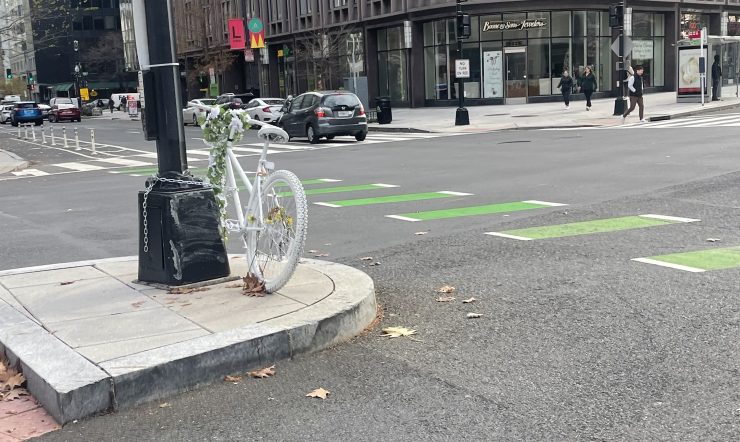
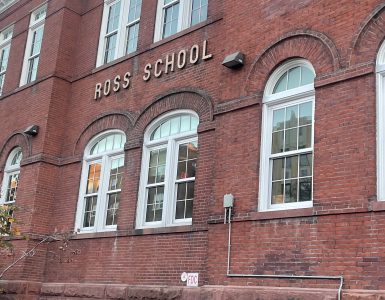
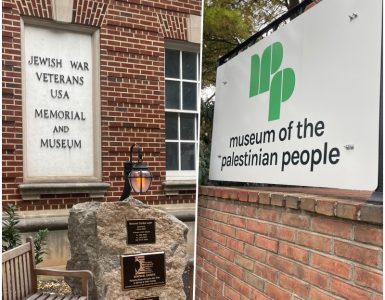
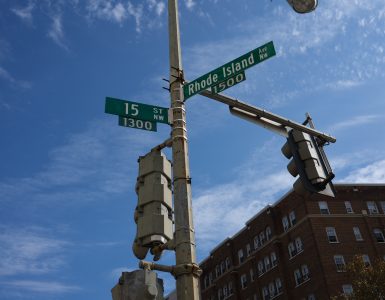










Add comment